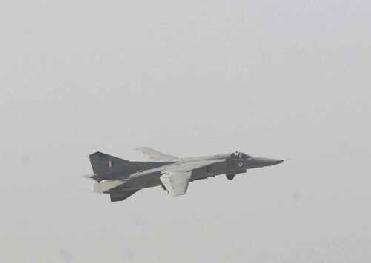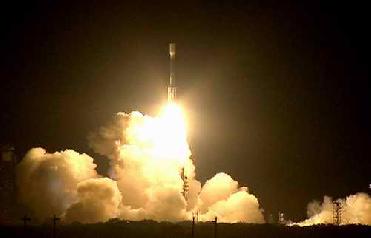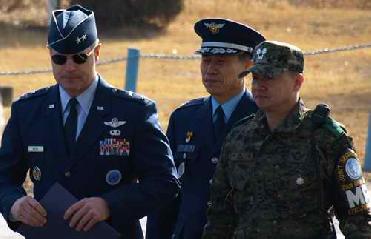
Last flight of the MiG-23 at Air Force Station Halwara on March 6, 2009. DPR photo
NEW DELHI (BNS): Curtains fell on MiG-23 BN of Indian Air Force on Friday, when it flew for the last time at Air Force Station Halwara. Chief of Air Staff, Air Chief Marshal Fali Homi Major, was present at the farewell function of MiG 23 BN at its headquarters No 221 Squadron.
Retiring after 28 years of glorious service to the nation, Wg Cdr YJ Joshi and Sqn Ldr TR Sahu of 221 Sqn flew the MiG-23 BN aircraft on its last flight.
The Air Force Station Halwara had become home to No 221 Squadron ever since they converted to MiG-23 BN in February 1982. Twenty-seven years on, No.221 Squadron is the lone Squadron with MiG-23 BN on its inventory. The squadron known as the ‘Valiants’ was formed on 1963 at Barrackpore under the command of Sqn Ldr N Chatrath with 22 officers. It was then a part of the 55 Bengal Auxillary Air Force Squadron. Initially equipped with Vampire, Spitfire and Hurricane aircraft, it assumed the mantle of an operational unit when selected to support Indian Army’s blitzkrieg advance in East Bengal during December 1971.
The ‘Valiants’ entered the Swing Wing era with the induction of MiG-23 BN in IAF on 24 January 1981 as a result of the IAF’s need for Tactical Air Strike Aircraft in the late 1970s. This single-seater ground attack aircraft was the result of Mikoyan Design Bureau’s radical approach to incorporate variable geometry wings in the aircraft, a swing wing concept to compromise on the conflicting requirement of high speed flight with good low speed handling. An IAF test pilot team led by Wg Cdr Philip Rajkumar had test flown and evaluated the MiG-23 BN at Lugovaya in April – May 1979 after which the Cabinet Committee for Political Affairs (CCPA) cleared an acquisition of 95 MiG-23 BNs. Eight Pilots, nine engineering officers and 55 airmen of IAF left for Soviet Union on September 1, 1980 for conversion training on MiG-23 variable sweep fighters. The aircraft were then transported to HAL facility at Ozar near Nasik where they were assembled, test flown by Soviet pilots before being handed over to the IAF on January 20, 1980. The first IAF unit to be inducted with these Swing Wing fighters was No. 10 Squadron.
The aircraft got its first taste of operation on April 4, 1984 when the Squadron was alerted for the launch of ‘Operation Meghdoot’ for securing the Siachen Glacier in Northern Ladhakh. Intensive flying began in Kashmir Valley, the MiG-23 BNs were employed to the limits, flying in the mountainous region by day and night. In 1985 MiG-23 BN got the unique distinction of being the first fighter aircraft ever to cross Banihal Pass in J&K region by night.
On May 25, 1999, ‘Operation Safed Sagar’ was launched. The Indian Air Force was to commence offensive air action at first light of the next morning. The MiG-23 BNs were launched into action targeting enemy positions at Tiger Hill with 57 mm rockets and 500 Kg bombs. The ensuing seven weeks from May 26 and July 15 saw the squadron fly 155 attack missions more than those during December 1971 operations and accounted for 28 percent of total load drop and 30 percent of all missions flown in that area.
During the Kargil conflict this aircraft had the distinction of being the single aircraft type to fire the maximum weapon load over the dizzy heights of Dras and Kargil. The MiG-23s have had flown more than 154,000 hrs in the service of the nation.
 Previous Article
Previous Article Next Article
Next Article













The Indian Air Force, in its flight trials evaluation report submitted before the Defence Ministry l..
view articleAn insight into the Medium Multi-Role Combat Aircraft competition...
view articleSky enthusiasts can now spot the International Space Station (ISS) commanded by Indian-American astr..
view article